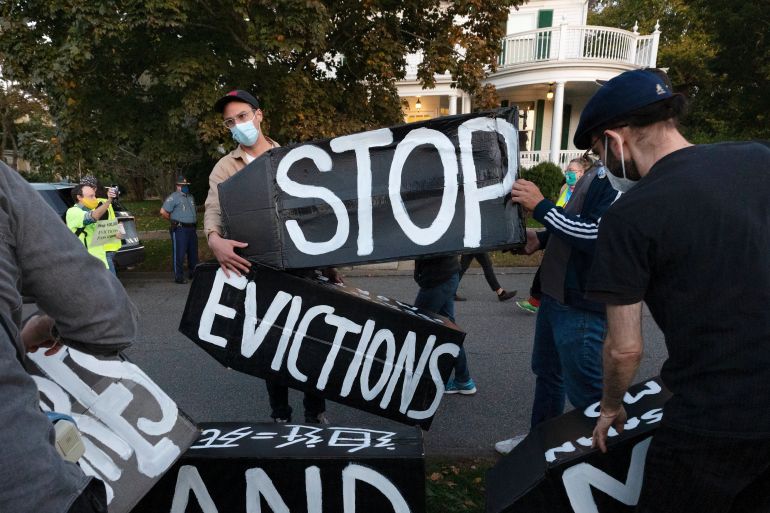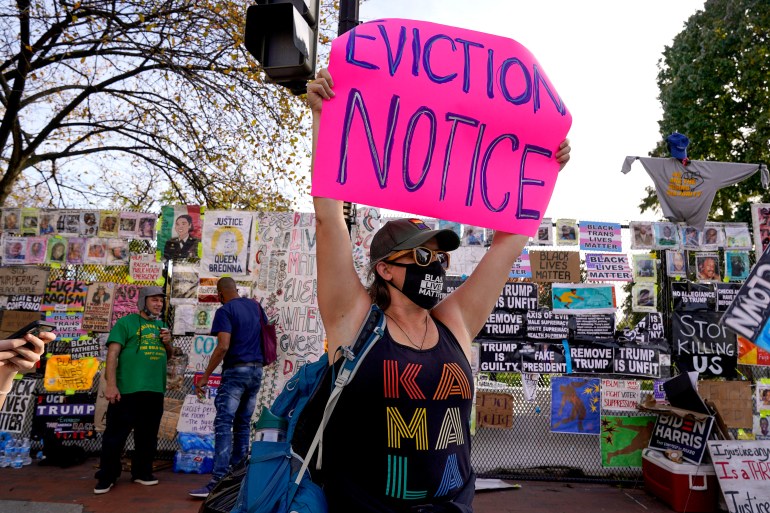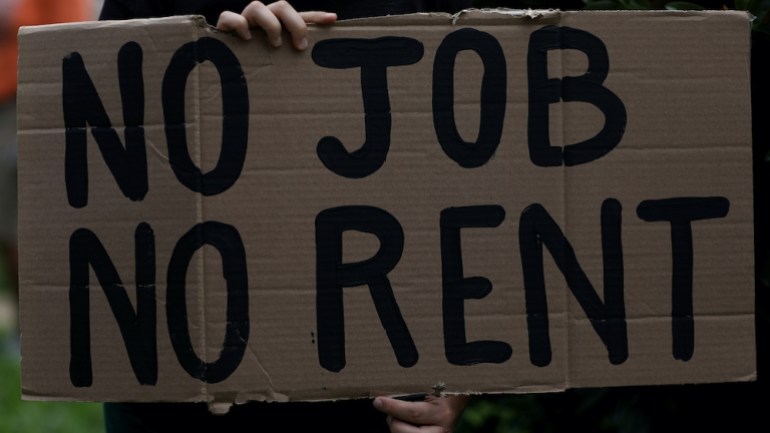What you need to know about America’s eviction crisis
New York passed a strong anti-eviction law Monday, but millions of Americans are at risk for eviction when other COVID-19 moratoriums expire, experts warn.

New York passed a sweeping law extending its eviction and foreclosure moratoriums until May 1 and bolstering credit protections for people struggling to pay their rent, mortgage or property taxes during the coronavirus pandemic.
New York Gov. Andrew Cuomo signed the COVID-19 Emergency Eviction and Foreclosure Prevention Act of 2020 into law late Monday, explaining that “the more support we provide for tenants, mortgagors and seniors, the easier it will be for them to get back on their feet when the pandemic ends.”
Keep reading
list of 4 itemsEviction looms for struggling US renters as stimulus talks drag
US landlords sue over eviction ban as tenants struggle to pay
CDC directs halt to renter evictions to prevent COVID-19 spread
Housing rights advocates have praised the move, but say more action is needed to protect tenants and homeowners nationwide.
Here’s what you need to know about the United States’ looming eviction crisis.
First of all, how many people are we talking about?
An estimated 30 to 40 million Americans are at risk for eviction, according to an analysis of US Census Bureau data by the nonprofit Aspen Institute, making it likely “the most severe housing crisis” in US history.
And while it didn’t start with the pandemic, “COVID-19 has shone a brighter light on the chronic US housing and eviction crisis,” said Marty Wegbreit, the director of litigation for the Central Virginia Legal Aid Society, whose work includes helping tenants facing eviction.
More than 1.7 million Americans said it was “very likely” they would have to leave their current homes in the next two months due to eviction, according to the Census Bureau’s Household Pulse survey for the week ending December 7. More than 1 million of those respondents are families with children.
Could evictions make the COVID-19 crisis worse?
Absolutely. If people are evicted from their homes and forced to stay with friends or family or in crowded temporary shelters, the potential for COVID-19 to spread increases.
In fact, modelling by a research team at the University of Pennsylvania found that across scenarios, “evictions lead to significant increase in infections”.

That has a real impact on deaths from the virus, too. A study by researchers at UCLA and Johns Hopkins University compared states with eviction moratoriums in place between March and September to those that lifted them, finding that lifting moratoriums led to an estimated 433,700 additional COVID-19 cases and an estimated additional 10,700 deaths.
Yikes. So what does New York’s new law do?
It prevents landlords from evicting tenants who file COVID-19 hardship declarations until May 1 and halts current eviction proceedings for people who qualify.
The law also halts residential foreclosures until May 1, allowing homeowners and landlords who own 10 or fewer residential dwellings to file hardship forms with their mortgage lenders, too.
Why is that important?
Small landlords who aren’t taking in rent can’t pay their own bills – including property taxes that fund schools, roads and other public services. Granting them some relief is important, too.
That’s why Wegbreit says New York’s law “offers a balanced approach to the eviction crisis. It not only blocks evictions of tenants with financial hardship, but also protects small landlords from foreclosure.”
What about those property taxes?
New York’s law pauses tax lien sales and tax foreclosures until at least May 1 and prevents lenders from discriminating against property owners who are behind on payments as long as they’ve filed a hardship form.
It also automatically extends tax exemptions for disabled homeowners and senior citizens, who rely on them to afford housing.

That sounds promising. What about the rest of the country?
A nationwide eviction moratorium from the Centers for Disease Control and Prevention (CDC) is currently in place until January 31. It was set to expire Thursday, but was extended as part of the latest stimulus bill.
Beyond the CDC’s moratorium, other states offer their own protections, but it’s a patchwork of laws that vary widely.
Virginia, for example, has offered more than $84m in rent relief money, and “landlords seeking eviction due to unpaid rent must give tenants 14-day nonpayment notices with information about rent relief,” Wegbreit said.
Beginning January 1, Virginia landlords “must apply for rent relief on the tenant’s behalf unless the tenant already has applied,” he added.
So does the CDC moratorium mean no one can be evicted right now?
Nope. In the 27 cities tracked by Princeton University’s Eviction Lab, landlords have filed for 162,563 evictions during the pandemic.
Tenants are only protected if they file a hardship declaration form, but any errors in that form or denial can still leave them at risk for eviction.
Does the moratorium waive rent?
No. Tenants on the hook for back rent when it expires and the nationwide CDC moratorium doesn’t waive late fees or penalties – so tenants will be responsible for unpaid rent as well as fees charged by their landlords.
New York’s moratorium, however, does waive late fees and lets tenants use the security deposits they paid at the start of their leases to make up back rent.
But that back rent really adds up. In the New York City borough of Manhattan, for example, the median asking rent was $2,800 per month in November, according to real estate data from StreetEasy.
And while that’s a 10-year low for the pricy island, a person who hasn’t been paying rent since the moratorium began would owe 10 months of back rent when it expires – a whopping $28,000.

Wow. Could anyone pay that?
That remains to be seen, particularly as the economic conditions that led to people falling behind on rent payments remain – such as high unemployment.
An estimated 10 million jobs lost at the start of the coronavirus pandemic in March have not come back. Unemployment benefits might help people pay some or all of their rent now, but are likely not enough to help pay back rent, too.
Is help on the way?
Yes, but it may not be enough. The House of Representatives passed a measure to up stimulus cheques to Americans from $600 to $2,000 at the request of President Donald Trump. Now it goes to the Senate for a vote.
The $900bn COVID-19 relief bill, signed by Trump on Sunday, also adds a $300 federal top-up to state unemployment benefits, providing some extra cash to people who are out of work.
But as you can see, a one-time payment of $2,000 isn’t going to make a dent in that back rent figure for a Manhattan apartment.
Evictions can also become a black mark on renters’ credit history – making it harder to find affordable and quality housing in the future. That’s why housing advocates say much more than a moratorium is needed to keep people in their homes long-term.